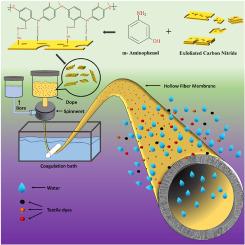聚间氨基酚功能化石墨氮化碳工程中空纤维膜的高效水净化
Q2 Materials Science
Current Research in Green and Sustainable Chemistry
Pub Date : 2025-01-01
DOI:10.1016/j.crgsc.2025.100480
引用次数: 0
摘要
工业化造成的水污染对生物的威胁很大,主要是由于染料废水和污染物排放到水体中。摄入这种受污染的水对生物体有有害的影响。为了解决这一问题,本研究以廉价的石墨氮化碳和间氨基酚为原料,合成了聚间氨基酚功能化石墨氮化碳(fcn)。采用FTIR、XPS、XRD、TGA、DTA、Zeta电位、粒度、TEM和BET等手段对合成的fns进行了表征。将这些fcn进一步掺入中空纤维膜中,随后使用SEM、AFM、Zeta电位、亲水性和性能研究对其进行分析。在制备的膜中,优化后的CN-AP 50膜的平均渗透率为150 Lm-2 h−1 bar−1,通量回收率为49.9%,可逆污染率为11.9%。此外,该膜对刚果红的去除率为99%,对活性黑5的去除率为98%,对活性橙16的去除率为86%。此外,在腐植酸存在下,它对铅离子的去除率达到99%,对汞离子的去除率达到60%。这些增强的排斥性和透水性是由于各种作用,如亲水性的改善,官能团之间的静电相互作用,与染料分子的π-π相互作用。这些影响也改变了膜的形态,从而增强了尺寸的排除和吸附能力。本研究讨论了一种将聚间氨基酚功能化石墨氮化碳作为添加剂用于膜制造的策略。功能化材料提高了透水性、防污性能和膜选择性,从而为先进的废水处理技术提供了可扩展的途径。本文章由计算机程序翻译,如有差异,请以英文原文为准。

Engineering hollow fiber membranes with poly-m-aminophenol functionalized graphitic carbon nitride for efficient water purification
Water pollution caused by industrialization poses a great threat to the living organisms mainly due to the release of dye wastewater and pollutants into the water bodies. Ingestion of such polluted water has detrimental effects on living organisms. To address the issue, the present study focuses on the synthesis of poly-m-aminophenol functionalized graphitic carbon nitride (FCNs) using inexpensive graphitic carbon nitride and m-aminophenol. The synthesized FCNs were characterized with FTIR, XPS, XRD, TGA, DTA, Zeta potential, Particle size, TEM and BET analysis. These FCNs were further incorporated into the hollow fiber membrane and subsequently analyzed using SEM, AFM, Zeta potential, Hydrophilicity, and performance studies. Among the fabricated membranes, the optimized CN-AP 50 membrane exhibited enhanced an average water permeability of 150 Lm-2 h−1 bar −1 and a Flux recovery ratio of 49.9 % with 11.9 % of reversible fouling. Furthermore, the membrane also displayed excellent dye rejection capacity of >99 % for Congo red, >98 % for Reactive black 5, and 86 % for Reactive orange 16. Additionally, it showed impressive heavy metal ion removal capability of 99 % for lead ions and 60 % for mercury ions in the presence of humic acid. These enhanced rejection and water permeability are due to the various effects such as improved hydrophilicity, electrostatic interaction between functional groups, π-π interaction with the dye molecules. These effects also modify the membrane morphology thereby enhancing size exclusion and adsorption capabilities. The present study discusses a strategy for incorporating poly-m-aminophenol functionalized graphitic carbon nitride as an additive in membrane fabrication. The functionalized material improves water permeability, antifouling performance, and membrane selectivity, thus offering a scalable route for advanced wastewater treatment technologies.
求助全文
通过发布文献求助,成功后即可免费获取论文全文。
去求助
来源期刊

Current Research in Green and Sustainable Chemistry
Materials Science-Materials Chemistry
CiteScore
11.20
自引率
0.00%
发文量
116
审稿时长
78 days
 求助内容:
求助内容: 应助结果提醒方式:
应助结果提醒方式:


